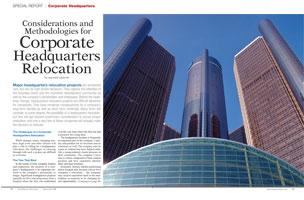
 Major headquarters relocation projects are somewhat rare, but can be high profile decisions. They capture the attention of the business world and the economic development community as well as the company’s stockholders and employees. Behind the headlines, though, headquarters relocation projects are difficult decisions for companies. They have immense consequences for a company’s long term identity as well as short term continuity. Many firms will consider, to some degree, the possibility of a headquarters relocation, but few will get beyond preliminary consideration to actual project evaluation, and only a very few of these companies will actually make the decision to relocate.
Major headquarters relocation projects are somewhat rare, but can be high profile decisions. They capture the attention of the business world and the economic development community as well as the company’s stockholders and employees. Behind the headlines, though, headquarters relocation projects are difficult decisions for companies. They have immense consequences for a company’s long term identity as well as short term continuity. Many firms will consider, to some degree, the possibility of a headquarters relocation, but few will get beyond preliminary consideration to actual project evaluation, and only a very few of these companies will actually make the decision to relocate.
The Challenges of a Corporate Headquarters Relocation
While strategic issues, changing markets, high costs and other factors will play a role in calling for a headquarters relocation, the challenges of carrying through with such a project are difficult to overcome.
The Ties That Bind
In the minds of both company leaders and employees, the location of a company’s headquarters is an important element in the company’s personality or image. Significant headquarters projects typically involve relocating away from a location where the firm was established or at the very least where the firm has had a presence for a long time.
 The headquarters location is frequently an important part of the company’s identity and position for its investors and its customers as well. The company may be a part of, indeed may have helped establish, a strong industry cluster presence in their community. The company’s location is a basic component of their market position and how customers identify them and their products.
The headquarters location is frequently an important part of the company’s identity and position for its investors and its customers as well. The company may be a part of, indeed may have helped establish, a strong industry cluster presence in their community. The company’s location is a basic component of their market position and how customers identify them and their products.
Ironically, historic market positioning tied to location may become a driver for a company’s relocation – the company may need to reposition itself in the marketplace in response to its changing future opportunities, and its old location may be too closely associated with its old market position.
The Human Resource Factor
People are what make up companies and people will be profoundly impacted by a headquarters relocation. In fact, it is important to note that people will be impacted by a potential headquarters relocation far in advance of the actual decision to move. This is one of the first challenges a company faces when such a project is considered. The mere suggestion of such a project can have a major impact on the morale and productivity of the current headquarters workforce. As a result, companies must initiate the discussion of a potential relocation with the smallest possible team under the strictest of external and internal confidentiality.
These decisions require considerable analysis of various internal operations on a department-by-department, even a person-by-person basis. So getting the needed information while maintaining confidentiality is a daunting challenge.
It is important to realize that individuals selected for this small project evaluation team are employees themselves and they too will be dealing with all the issues identified here. They will have their own opinions on the wisdom of the project and may not be supportive, on a personal level, with the decision to consider a headquarters relocation. As a result, the company risks getting biased input into the decision model and may find its schedule or confidentiality compromised by conscious or even subconscious actions of team members.
Continuity
 A headquarters relocation project is going to be very disruptive, and this disruption will take place at the core of the company and involve its highest executives and most important decision makers and managers. Companies considering headquarters relocations are likely to be in the midst of big changes – merger and acquisition activity, major repositioning in the marketplace, making major changes in their product and service offerings, etc. As a result, the demands a company and its management team are already facing may preclude them from embarking on a headquarters relocation before they even get started.
A headquarters relocation project is going to be very disruptive, and this disruption will take place at the core of the company and involve its highest executives and most important decision makers and managers. Companies considering headquarters relocations are likely to be in the midst of big changes – merger and acquisition activity, major repositioning in the marketplace, making major changes in their product and service offerings, etc. As a result, the demands a company and its management team are already facing may preclude them from embarking on a headquarters relocation before they even get started.
Cost
This is one of the toughest issues for a company to overcome when pursuing a relocation project. In most cases, the headquarters relocation is from a higher cost location to a lower cost, or at least equal cost, location. However, the cost savings of a new location are almost always less than the relocation costs. The bottom line to headquarters relocations is that they are almost always net-cost projects.
The costs items of a relocation project are similar to those of most new facility projects. In addition, there are some unique cost items associated with headquarter projects. The cost items include:
Property acquisition and disposition
Employee relocation
Employee retention
Employee severance
Employee hiring
Physical relocation
 It is necessary for firms to try to quantify the strategic advantages to the new location – to attempt to put dollar values on the driving reasons for the relocation. However, even when accounting for these beneficial factors, the firm is faced with comparing soft savings dollars with hard cost dollars. As a result, the company needs to be prepared to make a decision to proceed with a headquarters relocation in the face of a net-cost analytical result. The leadership of the firm must be convinced that the strategic and long term interests of the company are best served in a new location and that the firm must accept the costs as an investment in its future.
It is necessary for firms to try to quantify the strategic advantages to the new location – to attempt to put dollar values on the driving reasons for the relocation. However, even when accounting for these beneficial factors, the firm is faced with comparing soft savings dollars with hard cost dollars. As a result, the company needs to be prepared to make a decision to proceed with a headquarters relocation in the face of a net-cost analytical result. The leadership of the firm must be convinced that the strategic and long term interests of the company are best served in a new location and that the firm must accept the costs as an investment in its future.
Factors Important to Companies for a Headquarters Relocation
The reasons for a headquarters location can be powerful and compelling, and may overcome the costs and disruption of proceeding with such a project. Once the decision has been made to begin to look, what factors make alternative locations stand out?
Ability to Relocate, Attract and Retain Employees. Corporate headquarters projects involve the relocation of a substantial set of key employees in the organization to the new location. The new location must be one that enables the company to meet its employee relocation goals. Similarly, once relocated, companies must be confident their employees will want to stay. If the new location is qualitatively different than the old location (suburban area of large growing metropolitan area vs. downtown location in small older city), these employee risks get higher.
 Available Labor Force. While companies will relocate a significant portion of their existing workforce, the availability of a qualified labor pool for current and future vacancies will be an important factor in evaluating potential new communities. The relocating company will be entering the labor market with a significant immediate need for a wide range of office, business and technical positions. As with any new company, especially in an office environment, turnover should be anticipated; as a result, the demand on the labor market will remain strong for a while after relocation. Communities with a large presence of management operations (headquarters of all types – regional, divisional, etc) as well as high overall office sector employment, will be attractive. The presence of universities with business and engineering programs is important to most companies as they are a source of future employees.
Available Labor Force. While companies will relocate a significant portion of their existing workforce, the availability of a qualified labor pool for current and future vacancies will be an important factor in evaluating potential new communities. The relocating company will be entering the labor market with a significant immediate need for a wide range of office, business and technical positions. As with any new company, especially in an office environment, turnover should be anticipated; as a result, the demand on the labor market will remain strong for a while after relocation. Communities with a large presence of management operations (headquarters of all types – regional, divisional, etc) as well as high overall office sector employment, will be attractive. The presence of universities with business and engineering programs is important to most companies as they are a source of future employees.
Quality of Life. To many companies improving the quality of life for their employees is an important consideration. Companies look at factors such as the access to quality housing, low crime rates, shorter commute times, quality education at the primary, secondary and college levels, abundant quality day care and access to high quality health care when evaluating potential new communities. For companies relocating a headquarters with a large employee relocation element as well as a long term need for executive recruitment, quality of life requirements must include a wide and deep range of choices in cultural, recreational, religious, housing and education opportunities.
Cost of Living. The overall cost of living is a very important consideration for headquarters projects. The most important element in this is the cost of housing where differences between areas such as metropolitan New York or Los Angeles versus alternative headquarters locations can be dramatic. This factor enters into the decision in a number of ways, including the ability to relocate key employees, to attract new employees in the future, and in overall salary and wage scale planning.
Cost of Doing Business. As mentioned above, many companies are looking for locations that will provide cost savings in their headquarter operations. For headquarters these operating cost savings include real estate (through lower building costs or lease rates), lower facility costs, lower initial salary rates (for local hires), and lower taxes (income, sales and property; both base and rate).
 Air Transportation. For most corporate headquarters, access to quality air transportation is critical. The ability to get to most major cities, including international access, is an important evaluation criteria. In particular, firms will examine specific flights (frequency, schedule, and cost) between the potential headquarters location and its most frequently visited cities including where the company has other operations. For executives and management personnel who fly frequently as part of their jobs, the ability to have this access with just one flight can also be important.
Air Transportation. For most corporate headquarters, access to quality air transportation is critical. The ability to get to most major cities, including international access, is an important evaluation criteria. In particular, firms will examine specific flights (frequency, schedule, and cost) between the potential headquarters location and its most frequently visited cities including where the company has other operations. For executives and management personnel who fly frequently as part of their jobs, the ability to have this access with just one flight can also be important.
Available Space. The presence of headquarters-quality buildings and sites is important. The actual headquarters site must be of the highest quality with regard to such factors as park and building amenities; proximity to appropriate, high-end commercial activity; and ease of employee access. The space itself must be able to accommodate new workplace design as most companies will take advantage of a relocation to redesign their operating space. Finally, for firms building their own building or campus, the availability of temporary headquarters space near the new headquarters location is critical.
Incentives
 It is often stated that incentives are not important to headquarters relocation projects. In the sense that incentives are not a driving issue, this is true, although that should be true for all location decision projects. In fact, like all projects, incentives become more important toward the latter stages of a decision. For headquarters projects, incentives may have an especially significant impact due to the fact the decision is more subjective among headquarters finalists than other projects, and the projects are typically “net-cost” to the company.
It is often stated that incentives are not important to headquarters relocation projects. In the sense that incentives are not a driving issue, this is true, although that should be true for all location decision projects. In fact, like all projects, incentives become more important toward the latter stages of a decision. For headquarters projects, incentives may have an especially significant impact due to the fact the decision is more subjective among headquarters finalists than other projects, and the projects are typically “net-cost” to the company.
In addition to traditional financial incentives (bond financing, tax incentives), some communities are offering assistance to help the company in the relocation process. Employee relocation costs are very high and can ultimately become a roadblock preventing a company from proceeding with the relocation. Communities that can offer direct financial assistance in the form of grants to offset the relocation costs will find themselves with an important competitive advantage. Even without cash grants, most communities seeking to attract headquarters will offer assistance in the form of organization of trips to the new community that will introduce employees to the community and its amenities.

